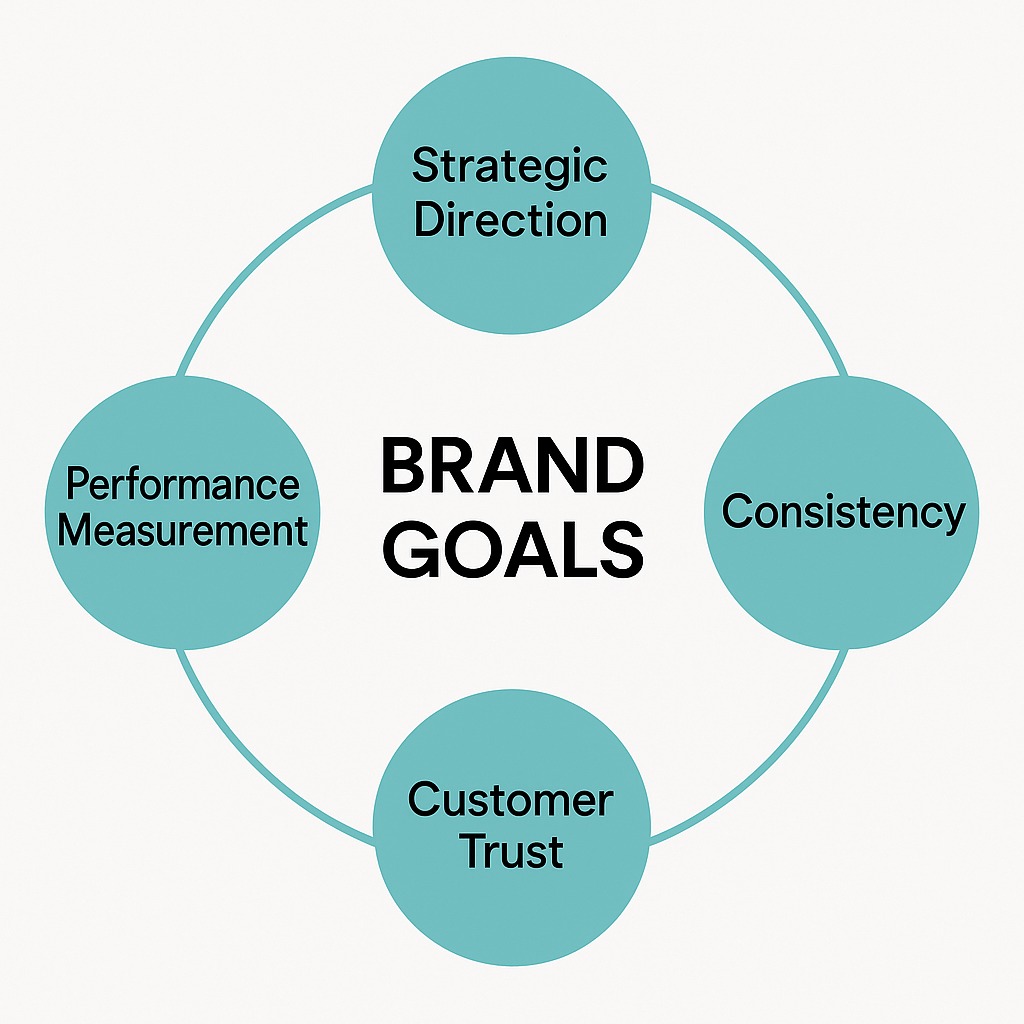In the competitive landscape of modern business, brand goals act as the guiding compass that directs every marketing effort, customer interaction, and growth decision. They define what a brand stands for, what it strives to achieve, and how it wants to be perceived. Without clear brand goals, even the most innovative companies risk losing focus, consistency, and customer trust.
A strong brand doesn’t just sell products—it builds relationships, shapes perceptions, and earns loyalty over time. Let’s explore why setting clear brand objectives is essential and how to build them strategically to drive long-term business success.
What is Brand Goals?
Brand goals are the clear, measurable objectives a company sets to shape how it is perceived, build customer trust, and drive long-term success. They represent the roadmap that connects your brand’s vision and values to real-world outcomes — such as awareness, loyalty, and advocacy. Unlike short-term marketing targets, brand goals focus on creating meaningful relationships and lasting recognition. They define what your brand wants to achieve in the minds of customers and how it plans to deliver consistent value. Whether it’s enhancing visibility, improving engagement, or increasing customer retention, strong brand goals ensure every business action aligns with a unified identity and purpose, helping your brand stand out and grow with authenticity.
Importance of Brand Objectives
Brand objectives are the measurable steps that transform your company’s mission and vision into tangible outcomes. They bring structure to your brand-building journey and help you align every action with a long-term purpose.
When defined clearly, brand objectives serve several critical purposes:

- Strategic Direction: They keep your brand focused on specific outcomes rather than random marketing experiments.
- Consistency: Objectives ensure that your messaging, tone, and visual identity stay aligned across all channels.
- Performance Measurement: They allow you to assess what’s working and what needs improvement through data-driven evaluation.
- Customer Trust: Consistent and goal-oriented brands naturally gain credibility and loyalty.
In essence, strong brand objectives transform abstract ideas into actionable strategies, helping businesses evolve with clarity and purpose.
Steps of Brand Goals
Creating impactful brand goals isn’t a one-time task — it’s a strategic journey that connects your vision to measurable progress. Each step acts as a building block that strengthens your brand’s foundation, ensuring every marketing action contributes to a unified identity and long-term growth. When you establish structured brand goals, you move beyond generic ambitions like “increase sales” or “get more customers” and start defining specific milestones that shape awareness, loyalty, and advocacy.
The process begins with building brand awareness, the stage where visibility and recognition start forming your audience’s first impressions. Then comes identifying your target audience, ensuring your message resonates with the right people. Once engagement begins, developing brand identity and building customer loyalty transform interest into trust. From there, you focus on enhancing brand engagement to create emotional connections that lead to customer advocacy — turning satisfied buyers into brand ambassadors. Finally, you measure and adjust, analyzing data to refine your approach for sustainable success.
These steps work in harmony, guiding your brand from obscurity to authority. They represent the disciplined roadmap every modern business must follow to stand out, connect deeply with its audience, and remain relevant in an ever-evolving marketplace.
1. Building Brand Awareness
Every brand journey starts with awareness. You can’t build loyalty or engagement if people don’t know your brand exists.
Brand awareness means making your target audience familiar with your name, logo, products, and values. It’s the first impression that determines how potential customers will perceive you.
Ways to build awareness:
- Leverage social media storytelling and visual branding.
- Use influencer collaborations and PR strategies.
- Invest in SEO and content marketing to improve discoverability.
- Participate in community or industry events to gain visibility.
Building awareness isn’t just about visibility—it’s about being remembered for the right reasons.
2. Identifying Your Target Audience
Defining your target audience ensures your brand message resonates with the right people. Instead of marketing to everyone, you focus on those most likely to engage and convert.
To identify your audience effectively:
- Conduct market research to understand demographics, behavior, and interests.
- Build buyer personas—fictional profiles that represent your ideal customers.
- Study competitors to uncover market gaps and opportunities.
- Use analytics tools to monitor audience engagement patterns.
Understanding your audience allows you to communicate in a language they trust and tailor your offerings to meet their needs precisely.
3. Building Customer Loyalty
Customer loyalty is the emotional and behavioral commitment your customers have toward your brand. It’s more cost-effective to retain loyal customers than to acquire new ones, making it one of the most valuable brand goals.
To build loyalty:
- Deliver consistent product quality and service.
- Create loyalty programs or reward systems.
- Personalize customer experiences through data-driven insights.
- Encourage feedback and respond promptly to issues.
Loyal customers not only buy repeatedly—they become advocates who promote your brand organically. A loyal base is a strong foundation for sustainable growth.
4. Develop Your Brand Identity
Your brand identity is more than a logo or color palette—it’s the personality, voice, and emotional appeal that makes your brand recognizable and relatable. It reflects who you are and what you stand for.
Key elements of brand identity:
- Logo and Visuals: Simple, memorable, and consistent across touchpoints.
- Brand Voice: The tone of communication—whether friendly, authoritative, or inspiring.
- Brand Story: A compelling narrative that connects emotionally with your audience.
- Values and Promise: The commitments that define your credibility and ethics.
A strong brand identity gives your company a human touch—making it easier for customers to connect and trust your message.
5. Enhance Brand Engagement
Brand engagement is about creating meaningful interactions with your audience—turning passive followers into active participants. High engagement indicates that people value your brand enough to interact, comment, and share.
Effective strategies for enhancing engagement:
- Develop interactive content such as polls, quizzes, or contests.
- Maintain an active social media presence with genuine conversations.
- Use storytelling to evoke emotions and responses.
- Provide value through blogs, videos, or educational resources.
The goal is to make customers feel like part of your brand’s journey—not just observers.
6. Increase Customer Advocacy
When your customers voluntarily promote your brand to make 3x growth, you’ve achieved the ultimate goal—customer advocacy. Advocates are brand evangelists who share positive experiences and drive organic growth.
Ways to build advocacy:
- Offer exceptional post-purchase support.
- Encourage user-generated content (UGC) through campaigns.
- Showcase customer testimonials and success stories.
- Build community spaces for customers to share experiences.
Brand advocacy amplifies credibility because recommendations from real users carry more weight than paid ads. It’s the most authentic form of marketing that sustains long-term success.
7. Measure and Adjust
Setting brand goals is not enough—they must be measurable and adaptable. Regularly tracking progress ensures you stay aligned with your objectives and can pivot when necessary.
Key metrics to measure:
- Brand Awareness: Track website traffic, search volume, and social reach.
- Engagement: Measure likes, shares, comments, and click-through rates.
- Loyalty: Analyze repeat purchases, subscription renewals, and churn rate.
- Advocacy: Monitor reviews, referrals, and UGC mentions.
Data-driven measurement reveals what’s resonating with your audience. Adjust your strategies based on insights to maintain consistent brand growth.
Additional Tips for Setting Brand Goals
To ensure your brand goals deliver results, keep these principles in mind:
- Be SMART: Goals should be Specific, Measurable, Achievable, Relevant, and Time-bound.
- Stay Authentic: Every goal should reflect your brand’s real purpose and values.
- Be Consistent: Repetition builds recognition and trust over time.
- Evolve with Trends: Consumer expectations change—keep your strategy flexible.
- Prioritize Value: Focus on how your brand improves your customers’ lives.
When goals are built on clarity and customer-centric values, success becomes a predictable outcome.
How Brand Goals Support Long-Term Growth
A brand without direction risks fading into irrelevance. Well-defined goals transform your marketing from reactive to proactive. Here’s how:
- Improved Alignment: Teams work more effectively when objectives are clear.
- Stronger Market Positioning: Goals help establish your niche and competitive advantage.
- Enhanced Trust: Customers trust brands that demonstrate consistency and purpose.
- Sustainable Growth: Instead of short-term gains, you build lasting relationships and reputation.
Brand goals connect vision with action—turning ambition into measurable progress.
Key Takeaways
Brand goals are not just marketing buzzwords—they are the foundation of every successful brand strategy. From building awareness to nurturing loyalty and advocacy, each stage contributes to a powerful, unified brand presence.
Key Takeaways:
- Brand objectives give direction and meaning to every marketing activity.
- Awareness and identity build the foundation for loyalty and advocacy.
- Measuring and adjusting ensures continuous improvement and relevance.
- Every goal must reflect authenticity, customer focus, and long-term vision.
In a world flooded with competitors, brands that set clear goals, deliver value, and stay consistent stand the test of time. Your brand’s success isn’t defined by how loud it speaks—but how clearly it communicates its purpose and fulfills it every single day.


